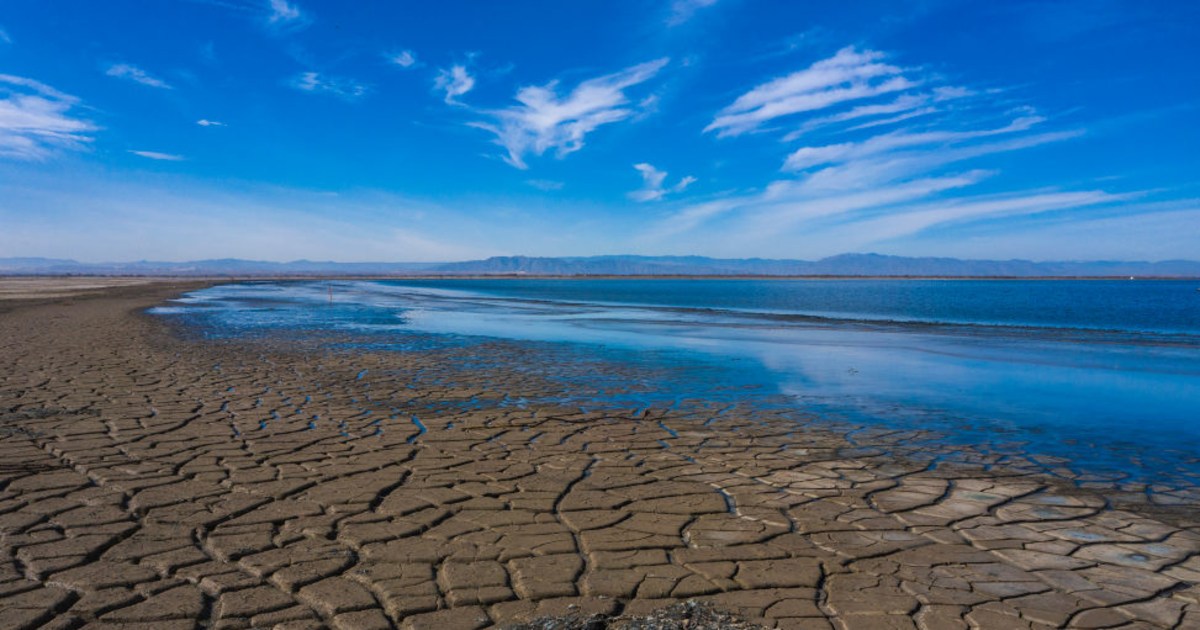The decrease in the water level of the Salton Sea salt lake, located in Southern California, could explain why the San Andreas fault has not yet caused the devastating earthquake that seismologists have predicted for years — the so-called Big One — according to research published Wednesday in the journal Nature.
The San Andreas fault, one of the largest in the world, at 800 miles (1,300 km) in length, delimits the North American plate from the Pacific plate and has three sections.
The southern, between Salton Sea and the small Californian town of Parkfield, has been without seismic activity for more than 300 years, something that is not good, according to scientists, who say that when the accumulated energy is released, it could have catastrophic consequences for large cities in the area, such as Los Angeles.
Salton Sea, located in Southern California and whose waters are receding, in an aerial image taken on February 13, 2021.David McNew / Getty Images
"This fault poses the greatest seismic hazard in all of California. The south of the San Andreas fault is a blocked section, and when this fault breaks it would cause significant damage in the greater Los Angeles area," said Ryley Hill, lead author of the study and a doctoral student at San Diego State University.
According to the U.S. Geological Survey (USGS), there is a 60% chance that a magnitude 6.7 earthquake will shake Los Angeles in the next 30 years.
How long will poor air quality in U.S. cities continue?
June 7, 202302:57
After collecting data from rocks near the fault, Hill and his colleagues found that earthquakes occurred roughly every 180 years — with a margin of error of 40 years — in that area, and coincided with the high water levels of ancient Lake Cahuilla, located nearby.
[Lawmakers Who Supported DeSantis' Harsh Immigration Law Now Asking Immigrants Not to Leave Florida]
Hill wondered that "if previous earthquakes in the area occurred every 180 years — with a margin of error of 40 years — why hasn't one happened in 300?" The question, according to the researcher, "made many scientists scratch their heads for many years. Understanding the history of this failure and what has caused ruptures in the past helps us understand what could happen in the future."
To understand how the water level has affected the fault's behavior, the scientists decided to create a computer model that analyzed how the weight of Lake Cahuilla's water caused the ground at the bottom to bend, which disconnected the plates so they wouldn't touch. That same water seeped into the empty spaces, increasing the pressure inside the fault and further separating the plates.
New York enters the list of the cities with the worst air quality in the world
June 7, 202300:20
Götz Bokelmann, a geologist at the University of Vienna, who was not involved in the study, called the relationship between the lake's water level and the likelihood of an earthquake "surprising." The finding, if proven, "is going to be very important," he said.
Although other studies on the region's behavior have come to different conclusions, the mechanism explained in the study is "very likely," Bokelmann said. Previous research had concluded that the effects of Lake Cahuilla were not as significant and that other faults within the Salton Sea had contributed to pressures in the area.
[Arctic Ocean forecast to lose all its ice for first time in next 20 years]
"Our study shows that the lake was sufficient to trigger large [earthquake] events, in the southern part of the San Andreas fault," Hill said.
The Santon Sea could, according to scientists, help cause an earthquake, but that is not a guaranteed fact.
Firefighters in Canada cause a fire to stop another of greater intensity
June 6, 202300:32
The odds of the Salton Sea filling Lake Cahuilla are effectively nonexistent. Lake Cahuilla was once 32 times larger than the present-day Salton Sea and was also fed by the Colorado River, which today has been impacted by drought. That, according to scientists, is good news.
[Floods spread across southern Ukraine after dam collapse and Russia acknowledges it favors its troops]
The bad news, however, is that Hill and the team that conducted the study determined that it's not just the volume of water that increases pressure on the plates, but also the rate at which the lake can be refilled. That fact, they said, could be a problem due to plans to restore and potentially fill in the Salton Sea, which has also been affected by climate change.

